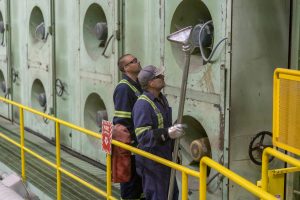Process safety management is a practice used in high-hazard industries like pulp and paper mills to help protect workers and the surrounding community.

Domtar Kamloops Mill
Photo credit: © WorkSafeBC (Workers’ Compensation
Board of B.C.), used with permission
You may not know what process safety is. “In a simple way, it’s keeping the stuff that’s supposed to be in the tanks and pipes in the tanks and pipes,” says Tony Ryan, health and safety superintendent at the Domtar Mill in Kamloops. Domtar, along with Cariboo Pulp and Paper in Quesnel, are featured in the WorkSafeBC video, Process Safety: Managing Risk in High-Hazard Sectors. The video shows how these plants have made process safety management (PSM) and process safety practices a core part of their operations.
Trevor Williams, an occupational hygiene officer with WorkSafeBC, explains that process safety management and process safety practices work hand in hand. “The goal of PSM is to understand the major hazards and risks at a work site, control those risks, and ensure that management of the hazards, risks, and controls is ongoing.”
Process safety practices are the processes themselves that help to protect a facility, its workers, and the nearby public from catastrophic outcomes such as fires, explosions, or toxic chemical releases. These types of accidents can result from things like equipment malfunctions, deterioration of equipment, or simple human errors, especially in complex operations involving hazardous materials and processes.
Preventing low-occurrence, high-consequence events
“Process safety focuses on those low-occurrence, high-consequence events, and includes steps the employer takes to mitigate those risks,” says WorkSafeBC safety officer Shane Campbell, in this video about the importance of process safety.
Shane and Trevor are part of a Process Safety Team that works with 15 pulp and paper mills and 2 smelters in B.C. They introduce and explain important concepts of PSM to employers, and work with managers, engineers, operators, and other key personnel to implement PSM or to improve and enhance current PSM practices.
Incidents frequently result from a combination of factors acting together. Trevor says, “The fundamental elements within process safety management are to analyze how things can go wrong, and to ensure adequate layers of protection to account for foreseeable deviations and potential vulnerabilities in control measures.”
Process safety engagements after incidents
Following a serious incident, a local WorkSafeBC prevention officer and possibly an investigations team may conduct an inspection or consult with the employer. They’ll meet to determine the cause and contributing factors that led to the incident. The Process Safety Team may also get involved, supporting the employer in the investigation. They’ll also review the employer’s safety plan and risk management practices, and discuss measures that could reduce the likelihood of a similar incident happening in the future.
Visit worksafebc.com to learn more about process safety and how you can develop a process safety plan.


